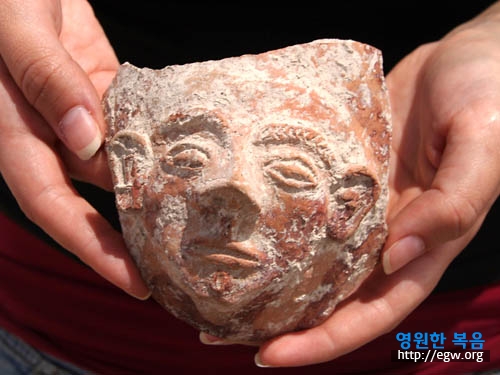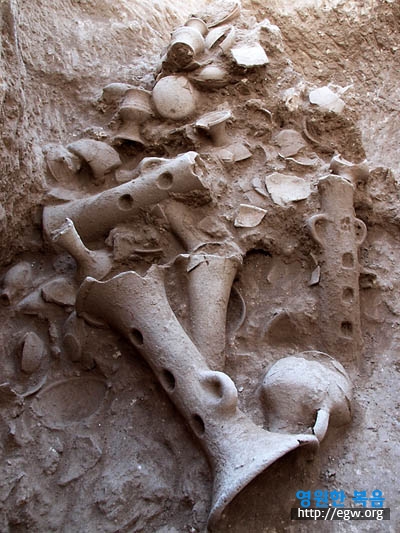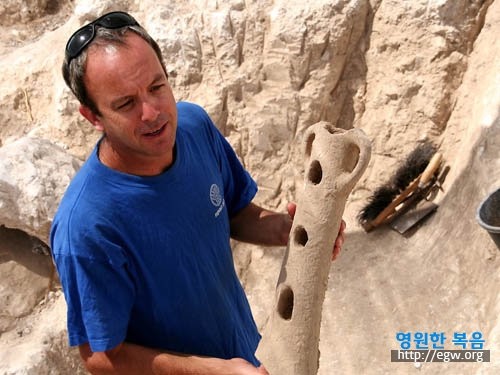Late Bronze cachet of pottery found next to Kishon brook near Carmel
koot van wyk (DLitt et Phil; ThD)
Kyungpook National University
Sangju Campus
South Korea
conjoint lecturer of Avondale College
15 June 2010
It is reported in the Jerusalem Post of 14 June 2010 in a video and also at a number of other online sites, that on the 7th of June 2010
"more than 100 ancient cultic vessels in a natural hollow in the bedrock next to the Tishbi (Yokneam) junction. In an excavation the Israel Antiquities Authority is conducting along the route of the northern gas pipeline planned by the Israel Natural Gas Lines Company. A natural hollow in the bedrock that was exposed in archaeological excavations by the Israel Antiquities Authority prior to the installation of the northern gas pipeline by the Israel Natural Gas Lines Company, at the foot of Tel Qashish (Tell el Qassis [or Tell Kassis]), did not cease to provide ancient surprises. For two weeks archaeologists of the Israel Antiquities Authority excavated the contents of the rock-hollow and removed from it more than 100 intact cultic vessels and other extraordinary items that are c. 3,500 years old" (Ferrell Jenkins for the World Press on the 7th of June 2010, see online site below).
Two archaeologists reported on the finds and in the video in the Jerusalem Post, dr. Edwin van den Brink reported.
"this is an extremely rare discovery. Until now no such pits as these have been found from 3,500 years ago. It is also extraordinary to find scores of vessels that are in such a good state of preservation. In most excavations fragments of pottery vessels are found, whereas here the vessels were removed from the rock-hollow intact. Each object was removed with the greatest of care, was drawn and documented and revealed beneath it a wealth of other finds. The vessels are numbered and their precise location in the heap is recorded for future research" (Ferrell Jenkins for the World Press).
The tel next to this find, tel Qashish is located on the northern bank of the Kishon river, where a bend in the stream encloses the site on two sides. Tel Yoqne`am is about 2km away and tel Qashish was dependent upon tel Yoqne`am. Tel Qashish covers an area of about 10.7 acres.
The mound slopes steeply on all sides except on the northeast where the approach road to the site was probably located (A. Ben-Tor, Ruhama Bonfil, and Sharon Zuckerman, "Tel Qashish: A Village in the Jezreel Valley" online source below and Qedem 5: Tel Qashish: A village in the Jizreel valley).
Van den Brink demonstrates a number of vessels on the video and one can see a stirup jar and a cultic incense burner.
Dating the find is still a major problem. Archaeological investigations at Tel Qashish indicates that it was abandoned after a major conflagration. Archaeologists Van den Brink and Ad tried to explain the situation this way: they had a date in mind which they did not reveal yet but they assumed that the Israelites were still in Egypt and thus ruled out that the vessels were moved by Israelites. They thought it belong to a pagan cult center who saw an impending approach of the enemy and then moved the vessels to hide them stagging them in this pit or cave. layers upon layers.
Our conclusions and observations
Our own approach is to hold conclusions at bay until the following list of findings becomes available:
1. it is important that the maximal and minimal time zones for the ceramic fashion is established. One needs to narrow the margin of the time zone of the fashions overlapping to find an upper date and a lower date.
2. it is important that at least some of the vessels have absolute dates with the help of scarabs, texts or other means.
3. Some questions need to be adressed:
3.1. why would they be carefully stagged?
3.2. why would they also be in a broken stage but nevertheless stagged?
3.3. They were hidden in a rush in the face of an oncoming enemy? Is there any indicating that it was definitely the Egyptians? The dating of the vessels will help to provide a time zone in which historical texts can fill in the gaps.
3.4. The face of the woman has Egyptian motifs in them although it may be a precursor to what one later called the Philistine coffins. But that is too late. Or is it? We need a time zone to establish these results.
3.5. A precise dating of these vessels are needed to show the upper and lower margin of dating. Connecting it to an event will be without these markers speculation.
Thutmosis III did approach but the Canaanites would not see a reason to hide since they were tributaries to Egyptian imperialism.
Thutmosis III would attack a city that resisted the Egyptian system of tax.
Joshua also attacked between 1410-1405 BCE.
The Amarna letters also reported the presence of Hurrians and Hittites in the area as well as Kassites in some other texts.
Deborah attacked the area in the early thirteen century BCE.
We need to see if the Greece imports connects it to dates later than Joshua's attack and more in time of Deborah. These aspects need to be established first.
3.6. To list the Elijah event is far too late for these vessels.
There is no doubt that the find is very valuable for future understanding of the Bible and the times of the Bible. As soon as we can answer the above questions, it will be possible to link it to the biblical text and other texts.
Sources:
1. http://ferrelljenkins.wordpress.com/2010/06/07/3500-year-old-discovery-at-tell-kassis-qassis/
2. http://www.whitelevy.org
3. http://www.jpost.com 14 June 2010 where the video is available.
4.Photos from the above sites are relevant.



















